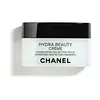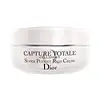What's inside
What's inside
 Key Ingredients
Key Ingredients

 Benefits
Benefits

 Concerns
Concerns

 Ingredients Side-by-side
Ingredients Side-by-side

Water
Skin ConditioningGlycerin
HumectantOctyldodecyl Neopentanoate
EmollientHydrogenated Polyisobutene
EmollientSilica
AbrasiveC12-15 Alkyl Benzoate
AntimicrobialPentylene Glycol
Skin ConditioningOctyldodecanol
EmollientPEG-40 Stearate
EmulsifyingCamellia Kissi Seed Oil
EmollientGlyceryl Stearate
EmollientAmmonium Acryloyldimethyltaurate/Vp Copolymer
Zingiber Officinale Root Extract
MaskingCamellia Japonica Flower Extract
EmollientButyrospermum Parkii Butter
Skin ConditioningPhytosteryl Canola Glycerides
Skin ConditioningPhenoxyethanol
PreservativeSaccharide Isomerate
HumectantCetyl Alcohol
EmollientSteareth-2
EmulsifyingDimethicone
EmollientParfum
MaskingCaprylyl Glycol
EmollientSodium Carbomer
Emulsion StabilisingLauroyl Lysine
Skin ConditioningPropylene Glycol
HumectantPEG-12
HumectantPentaerythrityl Tetra-Di-T-Butyl Hydroxyhydrocinnamate
AntioxidantSodium Hyaluronate
HumectantSodium Citrate
BufferingPhytic Acid
Citric Acid
BufferingTocopherol
AntioxidantAscorbyl Palmitate
AntioxidantSodium Benzoate
MaskingWater, Glycerin, Octyldodecyl Neopentanoate, Hydrogenated Polyisobutene, Silica, C12-15 Alkyl Benzoate, Pentylene Glycol, Octyldodecanol, PEG-40 Stearate, Camellia Kissi Seed Oil, Glyceryl Stearate, Ammonium Acryloyldimethyltaurate/Vp Copolymer, Zingiber Officinale Root Extract, Camellia Japonica Flower Extract, Butyrospermum Parkii Butter, Phytosteryl Canola Glycerides, Phenoxyethanol, Saccharide Isomerate, Cetyl Alcohol, Steareth-2, Dimethicone, Parfum, Caprylyl Glycol, Sodium Carbomer, Lauroyl Lysine, Propylene Glycol, PEG-12, Pentaerythrityl Tetra-Di-T-Butyl Hydroxyhydrocinnamate, Sodium Hyaluronate, Sodium Citrate, Phytic Acid, Citric Acid, Tocopherol, Ascorbyl Palmitate, Sodium Benzoate
Water
Skin ConditioningGlycerin
HumectantNiacinamide
SmoothingCaprylic/Capric/Succinic Triglyceride
EmollientButylene Glycol
HumectantDicaprylyl Ether
EmollientCetyl Alcohol
EmollientGlyceryl Stearate
EmollientPEG-100 Stearate
Hydrogenated Coco-Glycerides
EmollientLauroyl Lysine
Skin ConditioningJojoba Esters
EmollientIsostearyl Hydroxystearate
EmollientC10-18 Triglycerides
EmollientPolyglyceryl-3 Beeswax
EmulsifyingAframomum Angustifolium Seed Extract
Skin ConditioningPaeonia Lactiflora Root Extract
Skin ConditioningLilium Candidum Bulb Extract
Skin ConditioningJasminum Officinale Flower Extract
MaskingAscorbyl Glucoside
AntioxidantAdenosine
Skin ConditioningSodium Tocopheryl Phosphate
AntioxidantPalmaria Palmata Extract
Skin ProtectingHydrolyzed Soy Protein
HumectantParfum
MaskingStearyl Alcohol
EmollientMicrocrystalline Cellulose
AbsorbentXylitol
HumectantChlorphenesin
AntimicrobialPrunus Amygdalus Dulcis Oil
Skin ConditioningXanthan Gum
EmulsifyingCeramide NP
Skin ConditioningSodium Acetylated Hyaluronate
HumectantSodium Surfactin
CleansingCellulose Gum
Emulsion StabilisingSodium Hydroxide
BufferingTrisodium Ethylenediamine Disuccinate
Pentaerythrityl Tetra-Di-T-Butyl Hydroxyhydrocinnamate
AntioxidantSodium Benzoate
MaskingTrehalose
HumectantPotassium Sorbate
PreservativePaeonia Officinalis Flower Extract
TonicTocopherol
AntioxidantCI 14700
Cosmetic ColorantDimethicone
EmollientCaprylyl Glycol
EmollientAcrylates/C10-30 Alkyl Acrylate Crosspolymer
Emulsion StabilisingDimethiconol
EmollientAlpha-Isomethyl Ionone
PerfumingLimonene
PerfumingWater, Glycerin, Niacinamide, Caprylic/Capric/Succinic Triglyceride, Butylene Glycol, Dicaprylyl Ether, Cetyl Alcohol, Glyceryl Stearate, PEG-100 Stearate, Hydrogenated Coco-Glycerides, Lauroyl Lysine, Jojoba Esters, Isostearyl Hydroxystearate, C10-18 Triglycerides, Polyglyceryl-3 Beeswax, Aframomum Angustifolium Seed Extract, Paeonia Lactiflora Root Extract, Lilium Candidum Bulb Extract, Jasminum Officinale Flower Extract, Ascorbyl Glucoside, Adenosine, Sodium Tocopheryl Phosphate, Palmaria Palmata Extract, Hydrolyzed Soy Protein, Parfum, Stearyl Alcohol, Microcrystalline Cellulose, Xylitol, Chlorphenesin, Prunus Amygdalus Dulcis Oil, Xanthan Gum, Ceramide NP, Sodium Acetylated Hyaluronate, Sodium Surfactin, Cellulose Gum, Sodium Hydroxide, Trisodium Ethylenediamine Disuccinate, Pentaerythrityl Tetra-Di-T-Butyl Hydroxyhydrocinnamate, Sodium Benzoate, Trehalose, Potassium Sorbate, Paeonia Officinalis Flower Extract, Tocopherol, CI 14700, Dimethicone, Caprylyl Glycol, Acrylates/C10-30 Alkyl Acrylate Crosspolymer, Dimethiconol, Alpha-Isomethyl Ionone, Limonene
 Reviews
Reviews

Ingredients Explained
These ingredients are found in both products.
Ingredients higher up in an ingredient list are typically present in a larger amount.
Caprylyl Glycol is a humectant and emollient, meaning it attracts and preserves moisture.
It is a common ingredient in many products, especially those designed to hydrate skin. The primary benefits are retaining moisture, skin softening, and promoting a healthy skin barrier.
Though Caprylyl Glycol is an alcohol derived from fatty acids, it is not the kind that can dry out skin.
This ingredient is also used as a preservative to extend the life of products. It has slight antimicrobial properties.
Learn more about Caprylyl GlycolCetyl Alcohol is a fatty alcohol. Fatty Alcohols are most often used as an emollient or to thicken a product.
Its main roles are:
Though it has "alcohol" in the name, it is not related to denatured alcohol or ethyl alcohol.
The FDA allows products labeled "alcohol-free" to have fatty alcohols.
Learn more about Cetyl AlcoholDimethicone is a type of synthetic silicone created from natural materials such as quartz.
What it does:
Dimethicone comes in different viscosities:
Depending on the viscosity, dimethicone has different properties.
Ingredients lists don't always show which type is used, so we recommend reaching out to the brand if you have questions about the viscosity.
This ingredient is unlikely to cause irritation because it does not get absorbed into skin. However, people with silicone allergies should be careful about using this ingredient.
Note: Dimethicone may contribute to pilling. This is because it is not oil or water soluble, so pilling may occur when layered with products. When mixed with heavy oils in a formula, the outcome is also quite greasy.
Learn more about DimethiconeGlycerin is already naturally found in your skin. It helps moisturize and protect your skin.
A study from 2016 found glycerin to be more effective as a humectant than AHAs and hyaluronic acid.
As a humectant, it helps the skin stay hydrated by pulling moisture to your skin. The low molecular weight of glycerin allows it to pull moisture into the deeper layers of your skin.
Hydrated skin improves your skin barrier; Your skin barrier helps protect against irritants and bacteria.
Glycerin has also been found to have antimicrobial and antiviral properties. Due to these properties, glycerin is often used in wound and burn treatments.
In cosmetics, glycerin is usually derived from plants such as soybean or palm. However, it can also be sourced from animals, such as tallow or animal fat.
This ingredient is organic, colorless, odorless, and non-toxic.
Glycerin is the name for this ingredient in American English. British English uses Glycerol/Glycerine.
Learn more about GlycerinGlyceryl Stearate is a mix of glycerin and stearic acid.
It is used to stabilize the mixing of water and oil ingredients. By preventing these ingredients from separating, it can help elongate shelf life. It can also help thicken the product's texture.
As an emollient, it helps soften skin and supports barrier-replenishing ingredients.
In cosmetics, Glyceryl Stearate is often made from vegetable oils or synthetically produced.
This ingredient may not be fungal-acne safe
Fun fact: The human body also creates Glyceryl Stearate naturally.
Learn more about Glyceryl StearateThis ingredient comes from a fatty acid (lauric acid) and amino acid (lysine). It is used to add a silky feel to cosmetics.
According to a manufacturer, its fatty acid base leaves a silky feeling on the skin. It also has emollient properties because of this. Emollients help soften skin by preventing water from evaporating.
Lauroyl lysine is barely soluble in water.
Learn more about Lauroyl LysineParfum is a catch-all term for an ingredient or more that is used to give a scent to products.
Also called "fragrance", this ingredient can be a blend of hundreds of chemicals or plant oils. This means every product with "fragrance" or "parfum" in the ingredients list is a different mixture.
For instance, Habanolide is a proprietary trade name for a specific aroma chemical. When used as a fragrance ingredient in cosmetics, most aroma chemicals fall under the broad labeling category of “FRAGRANCE” or “PARFUM” according to EU and US regulations.
The term 'parfum' or 'fragrance' is not regulated in many countries. In many cases, it is up to the brand to define this term.
For instance, many brands choose to label themselves as "fragrance-free" because they are not using synthetic fragrances. However, their products may still contain ingredients such as essential oils that are considered a fragrance by INCI standards.
One example is Calendula flower extract. Calendula is an essential oil that still imparts a scent or 'fragrance'.
Depending on the blend, the ingredients in the mixture can cause allergies and sensitivities on the skin. Some ingredients that are known EU allergens include linalool and citronellol.
Parfum can also be used to mask or cover an unpleasant scent.
The bottom line is: not all fragrances/parfum/ingredients are created equally. If you are worried about fragrances, we recommend taking a closer look at an ingredient. And of course, we always recommend speaking with a professional.
Learn more about ParfumPentaerythrityl Tetra-Di-T-Butyl Hydroxyhydrocinnamate (long name, huh?) is a synthetic antioxidant.
It is used to help stabilize other antioxidants or prevent the color from changing in a product.
As an antioxidant, it helps fight free-radical molecules. Free-radical molecules are capable of damaging our cells and other genetic material. Thus, antioxidants may reduce the signs of aging.
This ingredient is oil-soluble.
Learn more about Pentaerythrityl Tetra-Di-T-Butyl HydroxyhydrocinnamateSodium Benzoate is a preservative. It's used in both cosmetic and food products to inhibit the growth of mold and bacteria. It is typically produced synthetically.
Both the US FDA and EU Health Committee have approved the use of sodium benzoate. In the US, levels of 0.1% (of the total product) are allowed.
Sodium benzoate works as a preservative by inhibiting the growth of bacteria inside of cells. It prevents the cell from fermenting a type of sugar using an enzyme called phosphofructokinase.
It is the salt of benzoic acid. Foods containing sodium benzoate include soda, salad dressings, condiments, fruit juices, wines, and snack foods.
Studies for using ascorbic acid and sodium benzoate in cosmetics are lacking, especially in skincare routines with multiple steps.
We always recommend speaking with a professional, such as a dermatologist, if you have any concerns.
Learn more about Sodium BenzoateTocopherol (also known as Vitamin E) is a common antioxidant used to help protect the skin from free-radicals and strengthen the skin barrier. It's also fat soluble - this means our skin is great at absorbing it.
Vitamin E also helps keep your natural skin lipids healthy. Your lipid skin barrier naturally consists of lipids, ceramides, and fatty acids. Vitamin E offers extra protection for your skin’s lipid barrier, keeping your skin healthy and nourished.
Another benefit is a bit of UV protection. Vitamin E helps reduce the damage caused by UVB rays. (It should not replace your sunscreen). Combining it with Vitamin C can decrease sunburned cells and hyperpigmentation after UV exposure.
You might have noticed Vitamin E + C often paired together. This is because it is great at stabilizing Vitamin C. Using the two together helps increase the effectiveness of both ingredients.
There are often claims that Vitamin E can reduce/prevent scarring, but these claims haven't been confirmed by scientific research.
Learn more about TocopherolWater. It's the most common cosmetic ingredient of all. You'll usually see it at the top of ingredient lists, meaning that it makes up the largest part of the product.
So why is it so popular? Water most often acts as a solvent - this means that it helps dissolve other ingredients into the formulation.
You'll also recognize water as that liquid we all need to stay alive. If you see this, drink a glass of water. Stay hydrated!
Learn more about Water